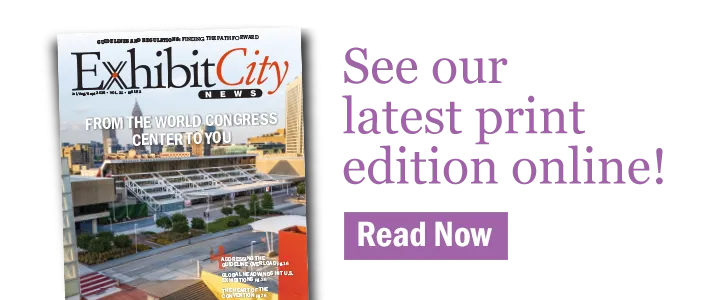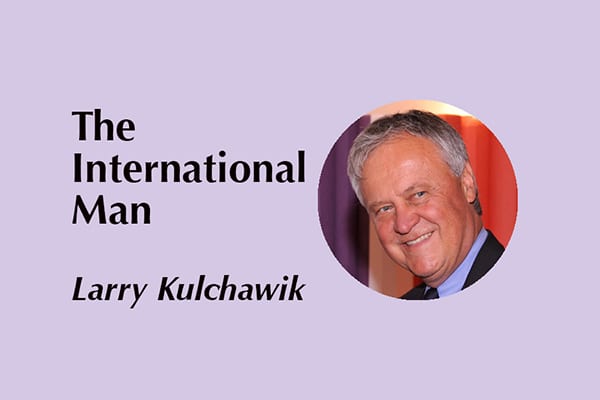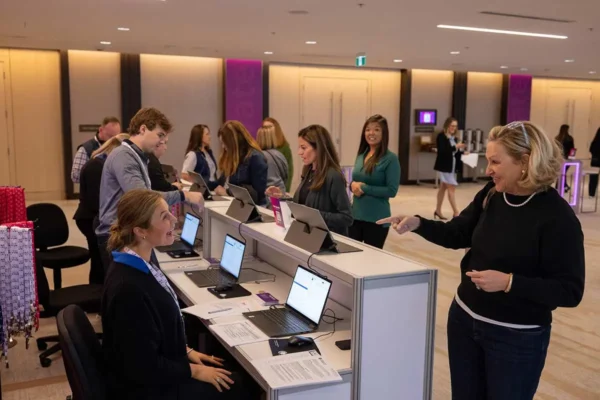by Larry Kulchawik, IFES past president
Since face-to-face marketing in all forms has been put on hold, virtual alternatives have been given more attention than in the past. Many of these virtual solutions are pretty darn creative as well. So while most all live events have been halted we must now begin to prepare for the return of live events with different requirements. As exhibit suppliers, our clients have grown to embrace some virtual methods as a temporary alternative.
As I talk to many of my peers in the exhibit industry, they all express their desire to get back to doing what we have done as soon as possible. The truth is, we will not be doing what we have done in the past the same any longer. The rules of the game have changed.
- Digital methods will be incorporated along with traditional face-to-face methods.
- Infection safety issues (masks, spacing, disinfectants) will be required at all venues.
- Tradeshow/event attendees will decrease, and the size of the exhibits will get smaller.
- Achieving more with less will be the challenge for companies to increase sales while maneuvering through the new rules for face-to-face marketing.
When the green light returns for meeting attendees to feel safe again about air flights, hotel accommodations, restaurants, convention facilities, and once again experience the true value of face-to-face meetings, we should all be prepared to roll out the red carpet to successfully service our client needs for the new world of live marketing. So what was the magic that made one media strategy stronger than the other? The answer is simple: live events create emotion where virtual events fall short.
Live encounters enable relationships to be created that influence a buyer’s decision to buy. Few virtual strategies can create an emotional connection as strong as a face-to-face experience. Now not all buying decisions need a face experience, but when buying a big ticket item you really want the personal reassurance that you made the right decision. Tradeshows mean business. So why are tradeshows and events so powerful? Because the selling/buying environment supports face-to-face communication where emotion plays a strong role.
Note that the power of emotion changes colors as we cross borders. Emotional conduct in Europe and Asia are different than in the U.S. In western (individualist) cultures high arousal emotions are valued and promoted more than the low arousal emotions promoted in Asia. When exhibiting abroad this concept needs to be fully understood when selling your product/services internationally. Check in with the IFES team to learn more.
When attendees choose to attend an event there are many levels of emotion that influence their decision to do so—an exciting city, a great restaurant, educational seminars, peer engagements and experiencing a eureka moment on the exhibit floor. Each of these deliver stimuli that is not experienced virtually. Unlike a virtual experience, a tradeshow selling environment does not allow you to multitask while engaging with another human, eyeball to eyeball.
As tradeshows move forward post COVID, measuring a return on a marketing investment will still be a marketing budget requirement for exhibit managers. Methods to measure ROI (Return on Investment) or ROO (Return on Objective) must now include ROE (Return on Emotion). How effective are we at generating emotional feedback within the tradeshow environments we create? With a return to face-to-face marketing, we will now face new challenges regarding the power of emotion within the exhibit/event environment. Prearranged appointments will be more common, so a safe meeting space will be more necessary than in the past. Additionally, three things will change in the design approach for exhibitor/attendee engagement.
 With everyone wearing a mask, we might not be able to see a person’s smile, smirk or frown. Facial signals that traditionally identified emotional feedback will add a layer of difficulty when attempting to form a relationship of trust.
With everyone wearing a mask, we might not be able to see a person’s smile, smirk or frown. Facial signals that traditionally identified emotional feedback will add a layer of difficulty when attempting to form a relationship of trust.- Since many will be reluctant to shake hands, or may be standing at a six-foot distance, new greeting and engagement methods must now be created.
- The traditional exhibit bar area (especially in Europe) will make food/drink hospitality more challenging. This area has always served to be the most effective place to let down your guard to begin a discussion.
I believe that the experts in our industry are getting much more sophisticated when discussing the true value of tradeshow marketing beyond the exhibit structure. One area of discussion is the art of engagement—exhibitor to attendee.
Beyond tradeshows, social scientists are gaining a greater understanding of how humans use their entire bodies to process and display emotions. “There has been much more progress in the study of face perceptions than with body language” says Alexander Todorov, author of Face Value: The Irresistible Influence of First Impressions.
“Because our attention is focused on the face, we underweight the importance of body gestures,” says Todorov. “Body language is important because it provides context for interpreting the meaning of facial expressions.” With facial expressions hidden, this will particularly offer a greater challenge for exhibitors to properly read emotional signals.
There is so much more to be learned here regarding our awareness and effectiveness for face-to-face marketing. But with masks and social distancing, the art of engagement and creating a trusting relationships for business will be more challenging. As an industry, exhibit designers must include emotional intelligence concepts to help our clients within the booth environment. The physical exhibit is only a prop to support the actors (exhibitors), who then effectively communicate on the stage (exhibit) to deliver a positive experience for their visitors. The human touch remains a key component for sales success.
Over the years our community of exhibit suppliers have added new skills and services beyond exhibit design that include catering, international, lead management, booth attractions, and ROO/ROI measurement services. We now enter a new world of tradeshow/event marketing where new design and measurement approaches will unfold. Associations like IFES can share and provide knowledge about the cultural differences when planning for an international event. Sharing ever-changing global knowledge will add rocket fuel to innovation and create the new normal in exhibit design. Embrace the new journey!
Larry Kulchawik is the head of Larry Kulchwawik Consulting and author of Trade Shows from One Country to the Next. For more info, visit www.larrykulchawik.com
This story originally appeared in the Jan./Feb. 2021 issue of Exhibit City News, p. 14. For original layout, visit https://issuu.com/exhibitcitynews/docs/ecn_jan-feb_2021























